Mysterious Gympie Pyramid: Evidence Of An Ancient Lost Civilization In Australia?
MessageToEagle.com – The Gympie Pyramid near the town of Gympie in Queensland, Australia has long been a source of fascination for people from around the world as well as Australia, and the subject of a great many claims about its origin and true purpose.
Archaeologist Greg Jefferys, who has worked on the pyramid, refers to it as a serious, famous and unexplained archaeological anomaly.
Unfortunately, academia and the government dismiss the pyramid on the grounds that it is a nineteenth-century or even more recent construction for the purpose of growing grapes, ignore evidence to the contrary and refuse to conduct an excavation that would settle the matter.
What is known as the Gympie Pyramid is the rounded eastern end of a sandstone ridge north of the town of Gympie that had stone terraces cut into the sides, giving it a pyramidal shape. It is not a pyramid in the Egyptian or South American sense. The pyramid is approximately 5 km from the center of Gympie, and is located north of the town on the Tin Can Bay road.
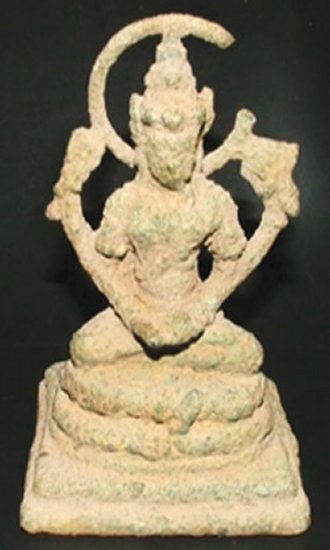
Ancient statuette of the Indian goddess Lakshmi dug up near the Gympie Pyramid.
Its interior remains unknown and has been a source of speculation, and there are believed to be three or four entrances, some blocked, leading into it.
The pyramid is 30.4 meters (100ft) high and has six stone terraces varying from 10 meters wide at the bottom to two meters wide towards the top, and incorporate some natural rock features. Stone for many of the terraces has been shaped, and squared and some of the larger stones used would be extremely heavy.
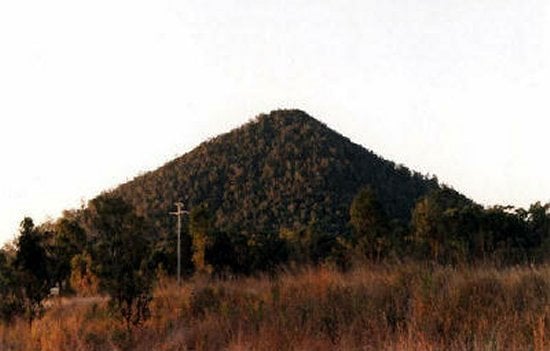
This pyramid-hill in the Rockhampton district, Queensland rises 90 meters high with its four sides facing the four points of the compass. Egypt-Phoenician rock inscriptions have been found in the vicinity of this structure by the Gilroys. Photo copyright: Rex Gilroy
When the pyramid was first discovered the summit is believed to have had thirteen pillars surrounding a round stone table with a hollow center standing on the summit, and a stone gateway standing on the lower slopes of the pyramid, and other standing stones inscribed with symbols. Most of these are believed to have been removed by early settlers. Fortunately they were recorded in a diary by John Green, a great grandfather of Brett Green, a local historian who has spent much of his life researching the pyramid, and is the author of a book entitled The Gympie Pyramid Story.
Gold was found at Gympie in 1867, and settlement began from that year. Early settlers naturally regarded the pyramid as an easy source of stone and it was quarried to supply new buildings, doing much damage and removing all the inscribed stones. Inscribed stones from the gateway were apparently found quite recently under the floor of one of the Gympie churches ? from where they vanished.
The pyramid became a source of much speculation and interest as unusual phenomena were reportedly seen or experienced on it, and unusual artifacts found nearby suggesting contact with earlier civilizations and was given publicity by writer Rex Gilroy.
Other Pyramids
Another pyramid, or a building which looked like one, is believed to have existed at what is now Tin Can Bay, on the coast from Gympie. (Tin Can Bay has nothing to do with tin cans.
The name is believed to be a corruption of tuncumba, the aboriginal name for dugong, possibly the indigenous name of the bay.) The area was taken over as an army base, and the story relates that the pyramid was covered with earth and used for target practice.
However, subsequent damage to the pyramid resulted in the discovery of carved stones used in its construction. At this point the army became worried about losing land to heritage purposes, and destroyed the pyramid. The carved stones were reputedly crushed and used to fill a creek, or else taken out and dumped in deep water.
This is believed to have taken place either in the 1940s, after World War II or in the 1950s.
See also:
Amanitore – Nubian Warrior Queen And Her Pyramids
El Mirador: Ancient Pyramids Hidden In The Lost City Of The Maya
One of the people who took part agreed to be interviewed years later, and mysteriously died on the day of the interview, the large police presence at the death causing some surprise.
Other pyramids have reputedly been found around Australia. The well-known surveyor Len Beadell is said to have found a pyramid on the Nullabor plains, and was told by the local aborigines that the pyramid was outside the dreamtime, and that it was very bad luck to talk about it. This pyramid is said to be made of stone, and largely buried, which is why it has not been located on Google Earth.
More recently, a passenger flying across central Australia saw a pyramid in the desert north of Alice Springs. One needs to bear in mind that central Australia used to be a lush area several millennia ago. A prophecy exists to the effect that a pyramid will be found in central Australia sometime this century, and that this site will be a major spiritual center. Other pyramids are believed to have been seen in New South Wales.
Archaeological Surveys
There has been no major archaeological excavation of the Gympie Pyramid. An archaeological survey was undertaken by Michael Morwood in 1967 (for some unknown reason this report is unobtainable). He attributed the construction of the terraces to Italian wine growers or other immigrants in the nineteenth century.
This idea was laid to rest by archaeologist Greg Jefferys, who did a survey while a student in 1990, and another survey and a limited excavation in 2007.
Jefferys found that the terraces were in some cases constructed with very heavy stones, some in excess of one ton in weight. And the terraces were too high for cultivation, the more so when you consider that they become more pronounced towards the top of the pyramid. Inspection of the soil in the terraces reveals only poor or rather thin native soils, becoming sandy in the top trenches, and show no sign of backfilling with more fertile soils. There is no trace of old vine stems, or roots or trellises, such as one would associate with former vine cultivation, and there is no equipment for wine making in the way of vats, etc. There would have been a major problem with watering the terraces, and there is no visible sign of any of the pipes and pumps that would be necessary.
Greg also found that the existing side of the pyramid faces south-east, making it unsuitable for wine growing, Vine cultivators are advised to use areas facing north.
He also found there had been no Italian community in Gympie before World War II, and research in the land titles office indicated that in any case the land had not been owned by the people credited with farming it. Greg points out that it would also be very unlikely for would-be cultivators to go to the trouble and effort of constructing the terraces when there is better and far more suitable land nearby.
Terraces are not usually constructed for agricultural purposes unless there is a shortage of arable land, which is certainly not the case in Gympie. Work with a bobcat in 2007 revealed how very poor the soils in the terraces were.
The aborigines did not build the pyramid, and are not known too have constructed stone terraces anywhere in Australia, or to have shaped stones.
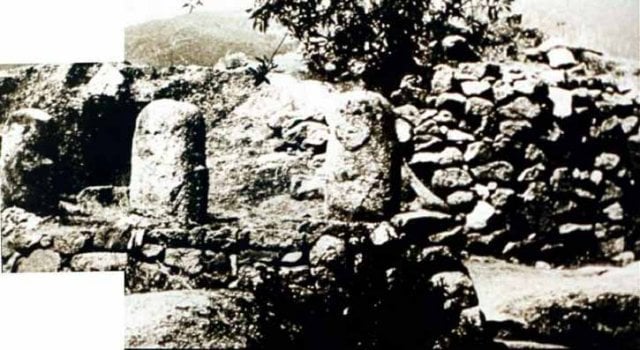
The Gympie pyramid and the Gympie ape.
If anything, they were afraid of the site and left it alone. Aboriginals taken to it in recent times declared they felt sick, and wanted to leave.
Quite possibly it was regarded as a place of evil spirits. Jefferys has pointed out that the Polynesians had a tradition of terracing hills for forts and religious purposes, of which examples exist on Raiaiti and Tonga that bear a resemblance to the Gympie terraces, so the pyramid could be of Polynesian origin.
If so, nothing else has been found on it to support this theory.
Dowsing has indicated there are a number of burials on the pyramid, but these have not been dug.
If so, this would suggest a sacred site. The purpose of the pyramid is not known. Greg Jefferys points out that it would have made a good fort given its location,12 but there is no evidence for this, and it does not ‘feel’ like one. It quite possibly had a ritual function, particularly given the pillars on the summit, and was possibly also used as an observatory. If it involved a ritual function then very possibly there would have been connections with the stars.
However, at the present time it can only be concluded the pyramid was built by unknown people for an unknown purpose.
Reports from Dowsers & Psychics
Dowsers have found the pyramid is on a major energy line, and energy rays out in four directions, like a Maltese cross. It is also connected by energy lines with what may be other pyramids or energy centers in the area. The pyramid may serve the function of drawing energy down (or up) and then radiating it over the countryside. Normally the destruction of such a center would have very serious consequences.
There is a powerful healing vortex at the top, near the grinders, and three people, including local resident and pyramid supporter Mick Dale, have, on separate occasions, experienced considerable healing for back problems there.
Psychics maintain the Gympie Pyramid has links with nearby and as yet undiscovered pyramids in the Gympie area, with pyramids in central Australia and the Nullabor, and with remains in Antarctica. It will be interesting when we are finally able to put together maps of the psychic centers around Australia.
There has been considerable consistency in the findings of psychics and clairvoyants visiting the site.
Brett Green mentions that local residents used to see ‘Nim Nim’ lights on top of the pyramid, and other phenomena have been encountered. One of the most frequently encountered apparitions are soldiers wearing bronze helmets and armor and holding shields. Since the 1960s people have encountered white-clad female spirits, who identified themselves as guardians of the site. Jefferys mentions a Betty Dodd who encountered a white clad apparition.
The most recent encounter took place last August when clairvoyant Michael English, who had no knowledge of previous reports, encountered a soldier in bronze armor and then two white clad ladies on the summit. One of these was blond and wore a heavy gold necklace. She gave her name as Nitarla, and said she was one of three such guardians (this name was also given to Mick Dale by another source as the name of the guardian. Michael had no knowledge of this). Nitarla said they had lived on the pyramid in antiquity, which was when the pyramid was bombarded, but they had elected to stay to try to protect it. Unfortunately they had been unable to stop the damage to the pyramid.
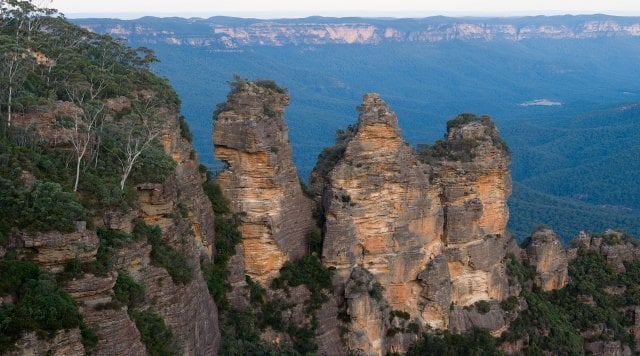
The Three Sisters towering above the Jamison Valley, Australia
The present writer also unexpectedly encountered a white-clad lady, this one with black hair, a couple of days later on the topmost terrace. This lady said nothing but bade him welcome by gestures. People about to ascend the pyramid frequently experience being ‘stopped’ by invisible means, and have to obtain permission before going up. The writer also found that an L-shaped dowsing rod, when held loosely in the hand, spun around freely by itself on the pyramid, usually a sign of a powerful site.
Michael English said the pyramid originally had a vortex on the top used to help spacecraft take off. This was destroyed when the pyramid was bombarded by banana shaped aircraft, possibly from Atlantis. This account has since been corroborated by another clairvoyant, Richard Shar, while using psychometry (reading the past) long distance from Adelaide.
Visiting psychics report seeing an inner chamber in the pyramid containing various artifacts, and in particular, commonly report seeing a large dark crystal. If so, this crystal would very probably be essential to the energy functions of the pyramid.
Individuals have had spiritual experiences equating to what is called ‘cosmic consciousness’ (a spiritual realization of higher consciousness and unity with all things) on the pyramid, and others have seen what may be the future (one person saw New Zealand splitting in two and sinking).
There is also thought to be antimony underground, which attracts lightning.
In the 1960s the summit of the pyramid was bulldozed by a person wanting to build a house. In doing so he is said to have destroyed the remaining two columns and dumped them in a mineshaft. Afterwards it is said he suffered illnesses, bad dreams and mechanical trouble, and started seeing figures in his house near the pyramid. He was thoroughly ‘spooked’ and left the area.
Unusual Objects
Several unusual objects have been found in and around the Gympie area. These include among other things (refer to illustrations on page 50): a carved, yellow stone head suggesting South American influence; an ancient statuette of the Indian goddess Lakshmi; a Grecian urn; an ancient Chinese bronze teapot, and an apparent stone statue of an ape-like figure, known as ‘The Gympie Ape’
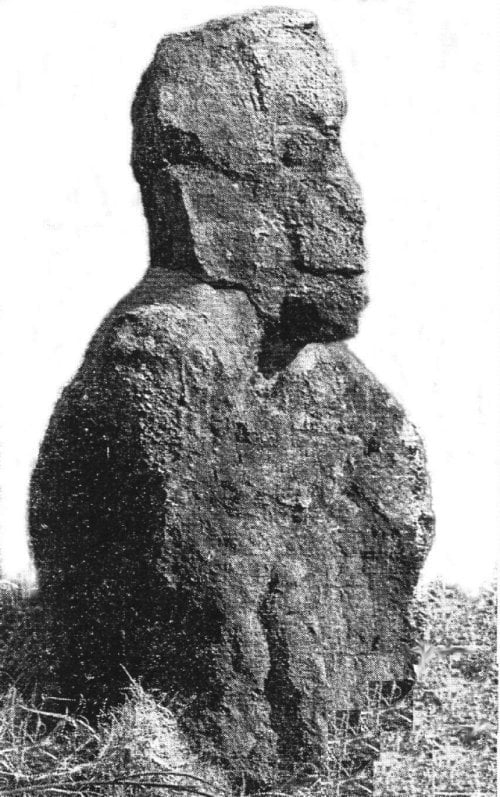
The Gympie Ape – A stone ape statue possibly 3000 years old. The statue was unearthed in 1966 on Mr. Dal K. Berrys Wolvi Rd property. The ape is made of conglomerate iron stone and shows a squatting ape figure. It is believed to represent the Egyptian God Thoth in ape form.
The archaeological value of these objects has been reduced by them being taken out of context, but they are still interesting. A piece of ‘bloomery’ iron was found more recently on the pyramid. According to aboriginal legend, lakes or seas used to extend from the coast almost to the base of the pyramid, which is apparently supported by geological evidence. This would account for foreign contact in the area, and seismic uplift has since emptied the lakes.
The carved yellow stone head was found next to the pyramid in 1985 after the construction of the railway line alongside the pyramid. The head is carved from a yellow conglomerate stone, usually an unlikely material for sculpture, which is not found anywhere near Gympie, if indeed it is found in Australia. The head has strong central or South American connotations, and it has been suggested it is of Olmec origin. The head has healing properties.
It’s also suggested that in constructing the railway, workers found either an entrance to the pyramid, or a large underground chamber containing artifacts. Either way, the railway is said to have removed the artifacts and filled up the chamber. The yellow head is thought to have been one that was mistakenly dropped during the excavation.
What is known as ‘The Gympie Ape’ was found in a paddock diagonally opposite the pyramid, by Dell Barry and Ken Blakemore, a former owner of the pyramid.
It was considered possibly to be a statue of the Egyptian god Thoth in ape form, or the Indian god Hanuman. The statue is in the Gympie Museum.
A bronze statuette depicting either the Indian goddess Lakshmi or the Tibetan goddess Tara was found in clay in a creek bed in the Gympie region. The amount of corrosion on the statuette suggests that it must be of ancient origin.
An ancient and unusual bronze and copper Chinese teapot or wine pot was found on Fraser Island, near Tin Can Bay. The corrosion on it indicates its age, and it may possibly have come from a shipwreck. The fact that it has three legs suggests it was a wine pot.
A bronze Grecian urn was found in the hills north of Gympie by Brett Green.
See also:
Cahuachi – Complex Of Truncated Adobe Pyramids In Peru’s Desert
A piece of bloomery iron was found on the pyramid along with other fragments during the 2007 visit by Greg Jefferys suggested smelting on the pyramid. This form of smelting has not been used in Australia as it died out in the Middle Ages, with some exceptions in parts of Asia. Other smelting related objects were found on the site, suggesting that smelting was done on site. So far three iron bars have been found on the pyramid, and at least one of these fits exactly into the central piercing of the flat diamond shaped stones. To date their purpose in doing so remains unknown.
Australian Eucalyptus was apparently and inexplicably found in Tutankhamen?s tomb. So were boomerangs believed to be of Australian origin. Gympie was a gold-mining area, which would account for members of other civilizations being there. It is rumored the gold in the funeral mask of Tutankhamen has been traced to Gympie.
Pyramid Site To Be Bulldozed
The Gympie Pyramid is a tourist attraction for the town of Gympie, which otherwise does not have a great deal to offer, and has brought in people from around the world. For all that, many Gympie residents still dismiss it as a myth.
Irrespective, the Queensland government intends to bulldoze the pyramid in the near future and put a highway through the site. Local objections have been overruled, and no attempt is being made to excavate or find out more about the pyramid while it still exists.
A lecturer in archaeology at the University of Queensland, Dr. Pranganell, said in an interview with the editor of the Gympie Times on 9 September 2006: The University has no intention of trying to test the myth as any digging on the site (of the Gympie Pyramid) would just give credibility to something that was impossible.?
People feel there is much more to be learnt from the Gympie Pyramid, and it should at least be properly excavated. It is an energy center, and also a tourist attraction for Gympie.
Normally, destruction of a major energy center such as this would have very serious consequences for the nearby community. In the Scottish highlands, moving even so small a sacred object as a standing stone is considered to bring bad luck, and crofters go to a lot of trouble to preserve the stones in situ. If so, destruction of a large site would result in more than bad luck. But the pyramid may have ways of striking back, which will be interesting to see.
If the pyramid is bulldozed and skeletons found, it will create a serious problem for the plans of the Queensland government, since it would have to regard it as a sacred site.
Efforts should be made to save the pyramid. It is possible to write to the local Member of Parliament, David Gibson, at 58 Channon St, Gympie QLD 4570. One can also meditate on saving the pyramid, and ask meditation and ritual groups to work to preserve the pyramid. Much will be lost if the Gympie Pyramid is destroyed, especially if it goes unexcavated and unexplored.
Written by: Gordon De L. Marshall – New Dawn
This article has been republished with permission of New Dawn Magazine
Copyright © New Dawn If you appreciated this article, please consider a digital subscription to New Dawn.
Related Posts
-
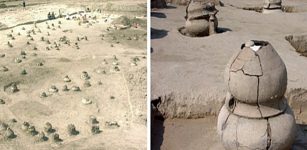 Bronze Age Vatya Culture: ‘Urnfield’ Cemetery And Remains Of A High-Status Woman
No Comments | Jul 30, 2021
Bronze Age Vatya Culture: ‘Urnfield’ Cemetery And Remains Of A High-Status Woman
No Comments | Jul 30, 2021 -
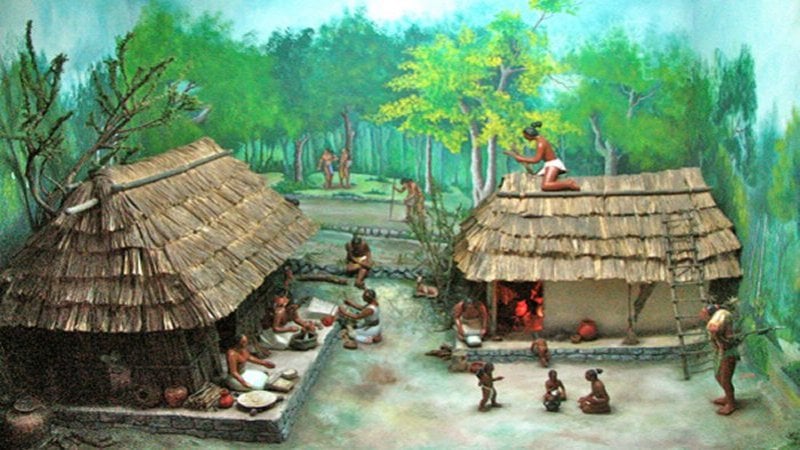 Daily Life Of Ancient Maya
No Comments | Oct 13, 2020
Daily Life Of Ancient Maya
No Comments | Oct 13, 2020 -
 Conwy Castle In Snowdonia: Outstanding Medieval Fortification In Europe
No Comments | May 18, 2016
Conwy Castle In Snowdonia: Outstanding Medieval Fortification In Europe
No Comments | May 18, 2016 -
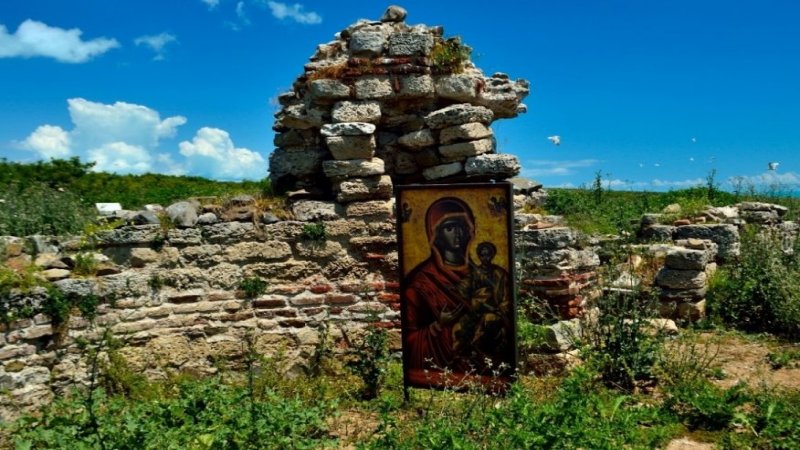 A 1,500-Year-Old Holy Well Probably With Healing Water – Discovered In Bulgaria
No Comments | Nov 25, 2020
A 1,500-Year-Old Holy Well Probably With Healing Water – Discovered In Bulgaria
No Comments | Nov 25, 2020 -
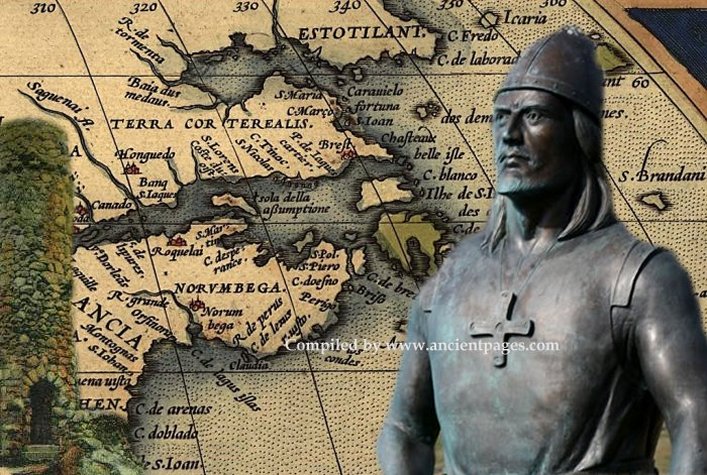 Is Legendary Norumbega In North America A Lost Viking Settlement?
No Comments | Jan 9, 2021
Is Legendary Norumbega In North America A Lost Viking Settlement?
No Comments | Jan 9, 2021 -
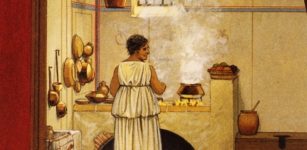 What Toilets And Sewers Tell Us About Ancient Roman Sanitation
No Comments | Nov 19, 2015
What Toilets And Sewers Tell Us About Ancient Roman Sanitation
No Comments | Nov 19, 2015 -
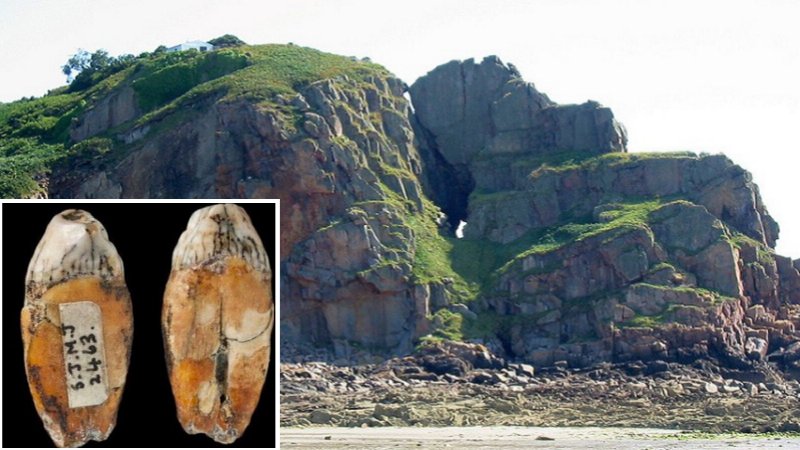 Evidence Of A Hybrid Population Of Neanderthals And Modern Humans Discovered At La Cotte De St Brelade
No Comments | Feb 9, 2021
Evidence Of A Hybrid Population Of Neanderthals And Modern Humans Discovered At La Cotte De St Brelade
No Comments | Feb 9, 2021 -
 Mystery Of The Chinchorro Civilization And The World’s Oldest Mummies
No Comments | Dec 27, 2016
Mystery Of The Chinchorro Civilization And The World’s Oldest Mummies
No Comments | Dec 27, 2016 -
 10 Ancient Love Symbols
No Comments | Jan 5, 2016
10 Ancient Love Symbols
No Comments | Jan 5, 2016 -
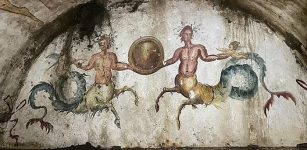 Remarkably Well-Preserved 2,000-Year-Old ‘Tomb Of Cerberus’ With Amazing Frescoes Discovered In Italy
No Comments | Oct 17, 2023
Remarkably Well-Preserved 2,000-Year-Old ‘Tomb Of Cerberus’ With Amazing Frescoes Discovered In Italy
No Comments | Oct 17, 2023
